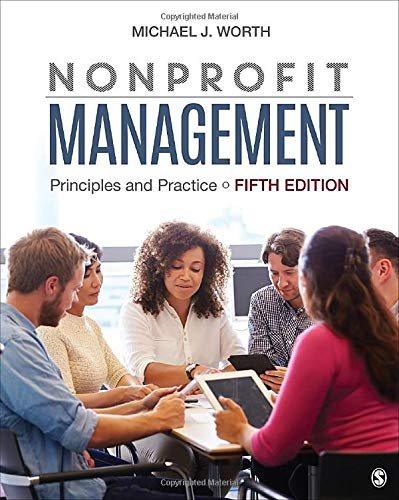When wounded veterans began arriving home from Iraq in 2003, John Melia remembered his own experience as
Question:
When wounded veterans began arriving home from Iraq in 2003, John Melia remembered his own experience as a Marine who had been shot down off the coast of Somalia in 1992. He began visiting returning Iraq War veterans in military hospitals, giving them backpacks with basic personal items they would need. The backpack project grew and Melia expanded the services to include sports programs, employment help, and other assistance to veterans. As the programs grew, he hired additional staff, including Steven Nardizzi, who had been an executive in a small nonprofit that also served veterans. By 2009, the project Melia had started, employed about 50 people, and raised $21 million in revenue. Melia and Nardizzi began to disagree about the pace of the organization's growth and the economy was in a recession, presenting new fundraising challenges. Melia resigned and Nardizzi became the CEO of the Wounded Warrior Project (Phillips, 2016a).
Nardizzi's model was not that of traditional veterans’ organizations, which often were similar to fraternal organizations or advocacy nonprofits. Under his leadership, the Wounded Warrior Project would adopt a business mindset, focusing on growth and on metrics to measure the performance of programs and staff members. “I look at companies like Starbucks,” Nardizzi said in one interview, “that's the model” (Phillips, 2016a). Soon after taking over as CEO in 2009, he doubled spending on fundraising and continued to increase it in following years (Phillips, 2016a). The organization expanded its programs to 22 locations and stepped up promotion. Fundraising soared and the Wounded Warrior Project became a well-known brand, with “its logo emblazoned on sneakers, paper towel packs, and television commercials that [ran] dozens of times” (Phillips, 2016a).
By some measures, the Wounded Warrior Project's spending on overhead, including fundraising and management, had reached 40 percent of its revenues in 2014, drawing the attention of charity watchdog organizations (Phillips, 2016a). Some former staff members also became critical, claiming that the emphasis on fundraising and performance metrics had begun to eclipse the commitment to the organization's mission. Some claimed that performance metrics were unrealistic and that numbers reported by the organization were misleading. For example, some said that veterans were being placed in low-paying jobs that were nevertheless counted just to meet the organization's employment targets. They argued that meeting the organization's goals had become more important than the impact of its programs on the wellbeing of veterans. Some former employees also were critical of what they deemed excessive spending
(Phillips, 2016a).
At the beginning of 2016, the Wounded Warrior Project was hit with criticism from multiple news media and charity watchdogs. The New York Times and CBS News ran stories citing lavish spending on events and travel, including a staff meeting in 2014 that brought 500 Wounded Warrior employees to the five-star Broadmoor hotel in Colorado (Phillips, 2016a). The organization's alumni events, which included trips to wine festivals, casino nights, and visits to resorts, also were criticized as too lavish (Sandoval, 2017).
Nardizzi argued that the expenditures were legitimate and that a growing organization must invest in fundraising in order to build the capacity to achieve its mission (Phillips, 2016b). The board initiated an independent investigation. The resulting report challenged some of the data cited by news media, arguing, for example, that 94 percent of the travel and conference costs were in fact incurred in connection with providing services to veterans and their families, not luxury travel by the staff (Hrywna, 2016). Senator Charles Grassley, chair of the Senate Judiciary Committee and a member of the Senate Finance Committee, also launched an investigation (Sandoval, 2017). Dan Pallotta, founder of the Charity Defense Council, established to refute criticisms of nonprofits, came to the defense of the Wounded Warrior Project and wrote to Grassley to express his views (Stiffman, 2016a)...................
Questions
1. Are the issues and questions raised in the Wounded Warrior Project case related to the concepts of accountability, performance, or both? How are those concepts related to this case?
2. Think back on the responsibilities of governing boards discussed in Chapter 3. How do they relate to the case of the Wounded Warrior Project?
3. Accounting rules permit nonprofits to allocate some costs between fundraising and programs; for example, the costs of a mailing that solicits gifts but also advocates for a cause may be apportioned between those two functions. Some people defend this practice while others say it is misleading to the public. What is your opinion?
4. This chapter discusses the view of Renz and Herman (2016) that nonprofit effectiveness is socially constructed, that is, it may be defined by what people perceive about the organization. How does that relate to the case of the Wounded Warrior Project?
Step by Step Answer:

Nonprofit Management Principles And Practice
ISBN: 9781506396866
5th Edition
Authors: Michael J. Worth





